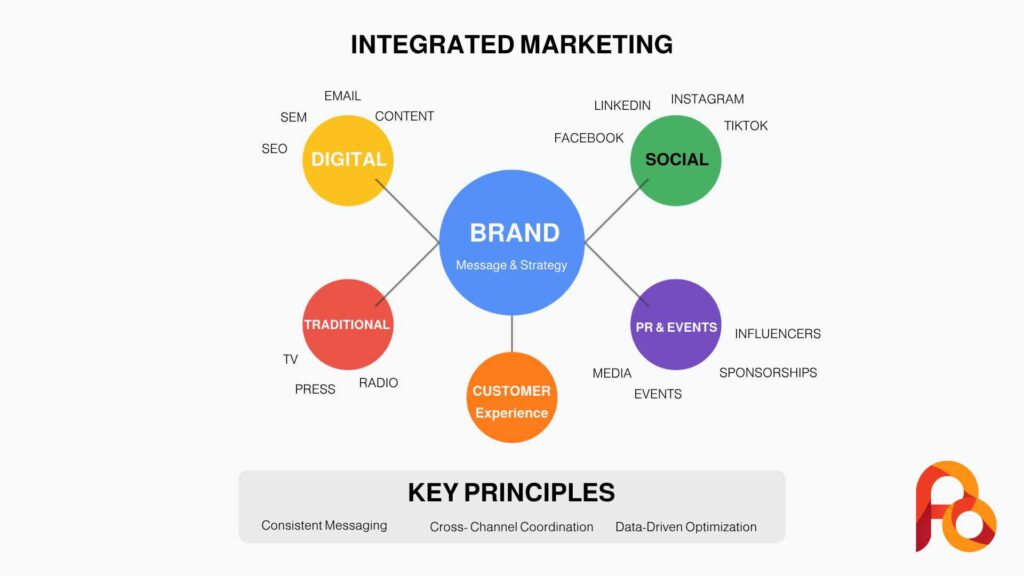First, let’s define Integrated Marketing.
It uses multiple communication channels collectively to create a consistent message for your church’s mission and events. Instead of creating separate campaigns for different channels, they will all work together with one unified message. This includes: social media, email, bulletins, sermons, website content, and newsletters. It doesn’t have to use identical graphics across all platforms. Practically, it shouldn’t. But it should include the same central theme and message. You’ll see…

Consistency Is Key
Several elements come into play with Integrated Marketing for churches:
- Messaging: The same core message is used on all channels for the promotion. It can include different graphics, videos, etc. But the central message is consistent for events, sermon series, or outreach.
- Focused: Tailor the message to your target audience. Not all church members have the same needs. Neither does the person who hasn’t stepped into your church yet. What young families need is different from what senior adults or teenagers need. Create several social media posts that contain the same core message while appealing to specific segments of your congregation.
- Data: If you aren’t using data to help create a core message for your audience, you could waste valuable time and resources. Try some A/B testing on posts to see what gets more engagement. This approach is critical to reach new visitors or a different demographic. If you don’t have the budget for paid promotion, try using your regular channels and track the results.
- A/B Test: Compares two versions of a webpage, app, social media post, or market ad to determine which performs better. It involves randomly showing users either version A (the control) or version B (the variation) and measuring differences in key metrics such as conversion rates, engagement, or click-through rates. Example: If you have a graphic for social media, take the original and change one element such as color, photo, or font, and see which performs better. Once you determine which performed better, use that as the new control graphic. You can do this multiple times. The key is changing only one element.
- Competitive Advantage: Look at what other churches in your area are doing. If they’re not practicing Integrated Marketing, you could gain greater visibility and impact in your community. This is not about competition but about effective stewardship of your resources to reach more people with your message.
Examples of Consistency for Churches
Here are just a couple of examples of consistency when incorporating Integrated Marketing in a church setting:
- A church promoting a new sermon series could incorporate relevant website content, social media posts, email announcements, bulletin inserts, and a short video trailer shared across all platforms.
- A church launching a community outreach event can use consistent graphic elements and messaging on its website, church app, Facebook Event page, and weekly newsletter.
Benefits Of Consistency for Churches
There are many benefits when your church is consistent in messaging:
- People will recognize your church brand: This could be from seeing your logo prominently displayed on all materials. It can also mean having specific color combinations or design elements associated with your church in all communications.
- Engagement Increases: Think about it. What’s more compelling to your congregation and community? Would they rather see a coordinated message or one that feels disjointed? Do they respond better to consistency, or would they prefer something unorganized? It seems like an easy choice.
- Better Stewardship: Consistency means better resource use. You’re investing time and effort in every social media post, announcement, and newsletter. Ensuring they work together maximizes the impact of each effort.
- Congregation Loyalty: Incorporating Integrated Marketing in everything you post or promote helps build a stronger sense of community and belonging among your congregation.
- Break Down Ministry Silos: Implementing these standards ensures that all ministry departments are working together to share information. When everyone is working toward the same goal, your church has no choice but to grow in effectiveness.
Summary
In today’s digital world, churches can use Integrated Marketing in all communications. A well-defined strategy and consistent implementation give your church a greater impact in sharing your message with your congregation and community.
Incorporate these ideas into your church communications today! The advantages of ministry are too significant to ignore. If you’d like help coordinating these efforts, schedule a consultation. In one hour, you’ll be able to implement some needed changes to your current system. For even more, ask about training sessions for your staff and volunteers.
